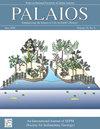UNLOCKING THE ARCHITECTURE OF THE COLONIZATION WINDOW: ICHNOFABRICS FROM UPPER CRETACEOUS TIDE-INFLUENCED MEANDER-LOOP DEPOSITS
IF 1.5
4区 地球科学
Q2 GEOLOGY
引用次数: 0
Abstract
Abstract: Studies dealing with the colonization window typically emphasize two major features: duration (short term vs. long term) and frequency of colonization (episodic vs. continuous). However, our understanding of tide-influenced meander loops requires consideration of an additional feature, the architecture of the colonization window, which comprises not only the spatial dimension and geometry of the colonization surface, but also its evolution through time. Tide-influenced meander-loop systems show a heterogeneous trace-fossil distribution that reflects the variety of processes operating along the point-bar and overbank colonization surfaces. Ichnofabric analysis of tide-influenced meander-loop deposits from the Upper Cretaceous Tremp Formation (Pyrenees, Spain) provides valuable insights into the sedimentary and ichnological dynamics of these marginal-marine systems and allows the importance of stratal geometry controlling the colonization window to be evaluated. Six ichnofabrics are identified in point bars and associated overbank deposits. These ichnofabrics differ in bioturbation index (e.g., higher in the upper part than the lower-middle parts of point bars), preservation of primary sedimentary fabric (typically preserved in the lower-middle parts of point bars), inferred behavior and trophic types (e.g., dominance of dwelling or feeding structures in the lower-middle and upper parts of point bars, respectively), and other features such as depth of penetration, ichnotaxonomic composition, presence or absence of root trace fossils and/or mottling, or number of superimposed suites. The key environmental factor controlling the nature and distribution of ichnofabrics is the morphology of the point-bar lateral-accretion surfaces and their evolution through time. The architecture of the colonization window is here linked to the helicoidal flow and discharge changes in meandering channels, and the successive development of lateral accretion units with time.解开殖民窗口的结构:来自上白垩纪受潮汐影响的曲流环沉积的生物结构
摘要:关于定殖窗口的研究通常强调两个主要特征:持续时间(短期vs长期)和定殖频率(偶发vs连续)。然而,我们对潮汐影响的曲流环的理解需要考虑另一个特征,即殖民窗口的结构,它不仅包括殖民表面的空间维度和几何形状,还包括其随时间的演变。受潮汐影响的曲流-环带系统显示出不均匀的痕迹化石分布,这反映了沿点坝和河岸殖民表面运行的各种过程。对上白垩统Tremp组(Pyrenees, Spain)受潮汐影响的曲流环沉积的技术结构分析为这些边缘海洋系统的沉积和技术动力学提供了有价值的见解,并允许评估地层几何形状控制殖民窗口的重要性。在点坝和相关的河岸沉积物中发现了六种技术结构。这些水体结构在生物扰动指数(例如,上部高于中下部分)、原始沉积结构的保存情况(通常保存在中下部分)、推断的行为和营养类型(例如,分别在中下部分和上部的居住或摄食结构占主导地位)以及其他特征(如渗透深度、鱼类分类组成)等方面存在差异。有无根迹化石和/或斑驳,或重叠套的数目。控制点坝侧向吸积面性质和分布的关键环境因素是点坝侧向吸积面的形态及其随时间的演化。在这里,殖民窗的结构与曲流通道的螺旋流和流量变化以及横向吸积单元随时间的连续发展有关。
本文章由计算机程序翻译,如有差异,请以英文原文为准。
求助全文
约1分钟内获得全文
求助全文
来源期刊

Palaios
地学-地质学
CiteScore
2.80
自引率
12.50%
发文量
40
审稿时长
6 months
期刊介绍:
PALAIOS is a monthly journal, founded in 1986, dedicated to emphasizing the impact of life on Earth''s history as recorded in the paleontological and sedimentological records. PALAIOS disseminates information to an international spectrum of geologists and biologists interested in a broad range of topics, including, but not limited to, biogeochemistry, ichnology, paleoclimatology, paleoecology, paleoceanography, sedimentology, stratigraphy, geomicrobiology, paleobiogeochemistry, and astrobiology.
PALAIOS publishes original papers that emphasize using paleontology to answer important geological and biological questions that further our understanding of Earth history. Accordingly, manuscripts whose subject matter and conclusions have broader geologic implications are much more likely to be selected for publication. Given that the purpose of PALAIOS is to generate enthusiasm for paleontology among a broad spectrum of readers, the editors request the following: titles that generate immediate interest; abstracts that emphasize important conclusions; illustrations of professional caliber used in place of words; and lively, yet scholarly, text.
 求助内容:
求助内容: 应助结果提醒方式:
应助结果提醒方式:


